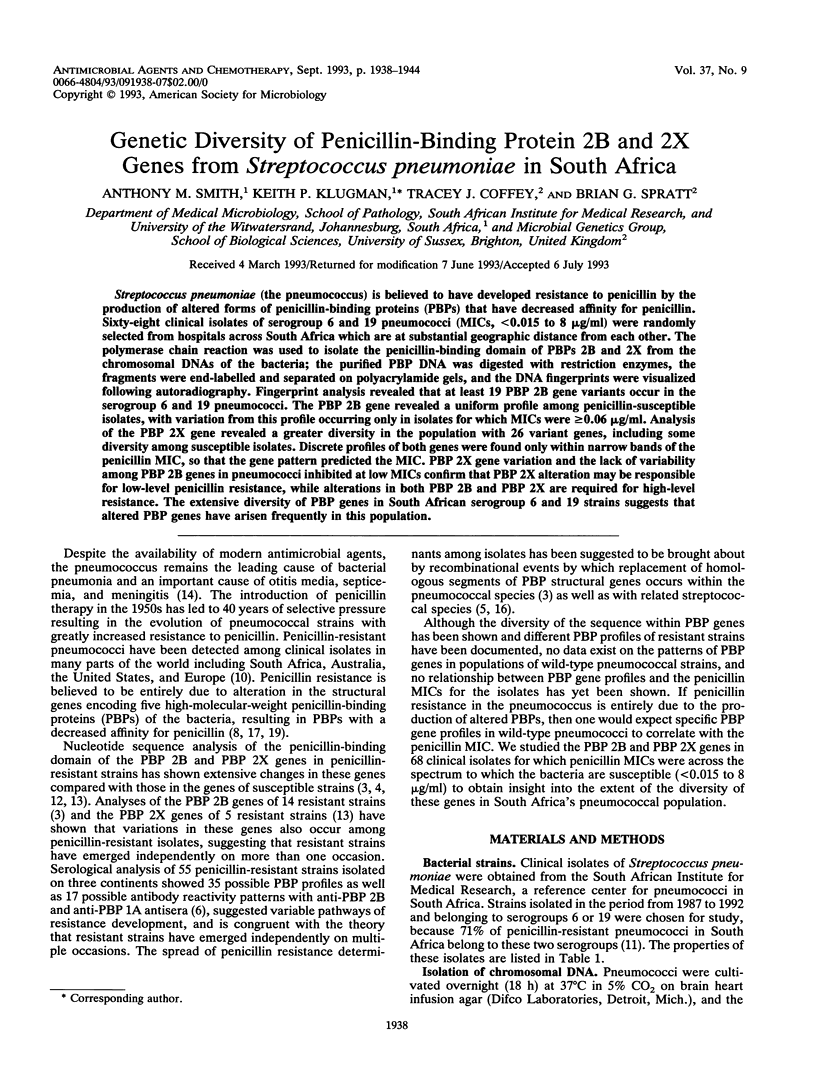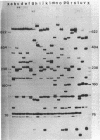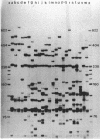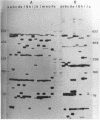Abstract
Streptococcus pneumoniae (the pneumococcus) is believed to have developed resistance to penicillin by the production of altered forms of penicillin-binding proteins (PBPs) that have decreased affinity for penicillin. Sixty-eight clinical isolates of serogroup 6 and 19 pneumococci (MICs, < 0.015 to 8 micrograms/ml) were randomly selected from hospitals across South Africa which are at substantial geographic distance from each other. The polymerase chain reaction was used to isolate the penicillin-binding domain of PBPs 2B and 2X from the chromosomal DNAs of the bacteria; the purified PBP DNA was digested with restriction enzymes, the fragments were end-labelled and separated on polyacrylamide gels, and the DNA fingerprints were visualized following autoradiography. Fingerprint analysis revealed that at least 19 PBP 2B gene variants occur in the serogroup 6 and 19 pneumococci. The PBP 2B gene revealed a uniform profile among penicillin-susceptible isolates, with variation from this profile occurring only in isolates for which MICs were > or = 0.06 micrograms/ml. Analysis of the PBP 2X gene revealed a greater diversity in the population with 26 variant genes, including some diversity among susceptible isolates. Discrete profiles of both genes were found only within narrow bands of the penicillin MIC, so that the gene pattern predicted the MIC. PBP 2X gene variation and the lack of variability among PBP 2B genes in pneumococci inhibited at low MICs confirm that PBP 2X alteration may be responsible for low-level penicillin resistance, while alterations in both PBP 2B and PBP 2X are required for high-level resistance. The extensive diversity of PBP genes in South African serogroup 6 and 19 strains suggests that altered PBP genes have arisen frequently in this population.
Full text
PDF






Images in this article
Selected References
These references are in PubMed. This may not be the complete list of references from this article.
- Coffey T. J., Dowson C. G., Daniels M., Zhou J., Martin C., Spratt B. G., Musser J. M. Horizontal transfer of multiple penicillin-binding protein genes, and capsular biosynthetic genes, in natural populations of Streptococcus pneumoniae. Mol Microbiol. 1991 Sep;5(9):2255–2260. doi: 10.1111/j.1365-2958.1991.tb02155.x. [DOI] [PubMed] [Google Scholar]
- Dowson C. G., Hutchison A., Spratt B. G. Extensive re-modelling of the transpeptidase domain of penicillin-binding protein 2B of a penicillin-resistant South African isolate of Streptococcus pneumoniae. Mol Microbiol. 1989 Jan;3(1):95–102. doi: 10.1111/j.1365-2958.1989.tb00108.x. [DOI] [PubMed] [Google Scholar]
- Dowson C. G., Hutchison A., Woodford N., Johnson A. P., George R. C., Spratt B. G. Penicillin-resistant viridans streptococci have obtained altered penicillin-binding protein genes from penicillin-resistant strains of Streptococcus pneumoniae. Proc Natl Acad Sci U S A. 1990 Aug;87(15):5858–5862. doi: 10.1073/pnas.87.15.5858. [DOI] [PMC free article] [PubMed] [Google Scholar]
- Hakenbeck R., Briese T., Chalkley L., Ellerbrok H., Kalliokoski R., Latorre C., Leinonen M., Martin C. Antigenic variation of penicillin-binding proteins from penicillin-resistant clinical strains of Streptococcus pneumoniae. J Infect Dis. 1991 Aug;164(2):313–319. doi: 10.1093/infdis/164.2.313. [DOI] [PubMed] [Google Scholar]
- Hakenbeck R., Briese T., Chalkley L., Ellerbrok H., Kalliokoski R., Latorre C., Leinonen M., Martin C. Variability of penicillin-binding proteins from penicillin-sensitive Streptococcus pneumoniae. J Infect Dis. 1991 Aug;164(2):307–312. doi: 10.1093/infdis/164.2.307. [DOI] [PubMed] [Google Scholar]
- Hakenbeck R., Tarpay M., Tomasz A. Multiple changes of penicillin-binding proteins in penicillin-resistant clinical isolates of Streptococcus pneumoniae. Antimicrob Agents Chemother. 1980 Mar;17(3):364–371. doi: 10.1128/aac.17.3.364. [DOI] [PMC free article] [PubMed] [Google Scholar]
- Handwerger S., Tomasz A. Alterations in kinetic properties of penicillin-binding proteins of penicillin-resistant Streptococcus pneumoniae. Antimicrob Agents Chemother. 1986 Jul;30(1):57–63. doi: 10.1128/aac.30.1.57. [DOI] [PMC free article] [PubMed] [Google Scholar]
- Klugman K. P. Pneumococcal resistance to antibiotics. Clin Microbiol Rev. 1990 Apr;3(2):171–196. doi: 10.1128/cmr.3.2.171. [DOI] [PMC free article] [PubMed] [Google Scholar]
- Koornhof H. J., Wasas A., Klugman K. Antimicrobial resistance in Streptococcus pneumoniae: a South African perspective. Clin Infect Dis. 1992 Jul;15(1):84–94. doi: 10.1093/clinids/15.1.84. [DOI] [PubMed] [Google Scholar]
- Laible G., Hakenbeck R., Sicard M. A., Joris B., Ghuysen J. M. Nucleotide sequences of the pbpX genes encoding the penicillin-binding proteins 2x from Streptococcus pneumoniae R6 and a cefotaxime-resistant mutant, C506. Mol Microbiol. 1989 Oct;3(10):1337–1348. doi: 10.1111/j.1365-2958.1989.tb00115.x. [DOI] [PubMed] [Google Scholar]
- Laible G., Spratt B. G., Hakenbeck R. Interspecies recombinational events during the evolution of altered PBP 2x genes in penicillin-resistant clinical isolates of Streptococcus pneumoniae. Mol Microbiol. 1991 Aug;5(8):1993–2002. doi: 10.1111/j.1365-2958.1991.tb00821.x. [DOI] [PubMed] [Google Scholar]
- Muñoz R., Coffey T. J., Daniels M., Dowson C. G., Laible G., Casal J., Hakenbeck R., Jacobs M., Musser J. M., Spratt B. G. Intercontinental spread of a multiresistant clone of serotype 23F Streptococcus pneumoniae. J Infect Dis. 1991 Aug;164(2):302–306. doi: 10.1093/infdis/164.2.302. [DOI] [PubMed] [Google Scholar]
- Potgieter E., Chalkley L. J. Reciprocal transfer of penicillin resistance genes between Streptococcus pneumoniae, Streptococcus mitior and Streptococcus sanguis. J Antimicrob Chemother. 1991 Sep;28(3):463–465. doi: 10.1093/jac/28.3.463. [DOI] [PubMed] [Google Scholar]
- Zhang Q. Y., Jones D. M., Sáez Nieto J. A., Pérez Trallero E., Spratt B. G. Genetic diversity of penicillin-binding protein 2 genes of penicillin-resistant strains of Neisseria meningitidis revealed by fingerprinting of amplified DNA. Antimicrob Agents Chemother. 1990 Aug;34(8):1523–1528. doi: 10.1128/aac.34.8.1523. [DOI] [PMC free article] [PubMed] [Google Scholar]
- Zighelboim S., Tomasz A. Penicillin-binding proteins of multiply antibiotic-resistant South African strains of Streptococcus pneumoniae. Antimicrob Agents Chemother. 1980 Mar;17(3):434–442. doi: 10.1128/aac.17.3.434. [DOI] [PMC free article] [PubMed] [Google Scholar]





